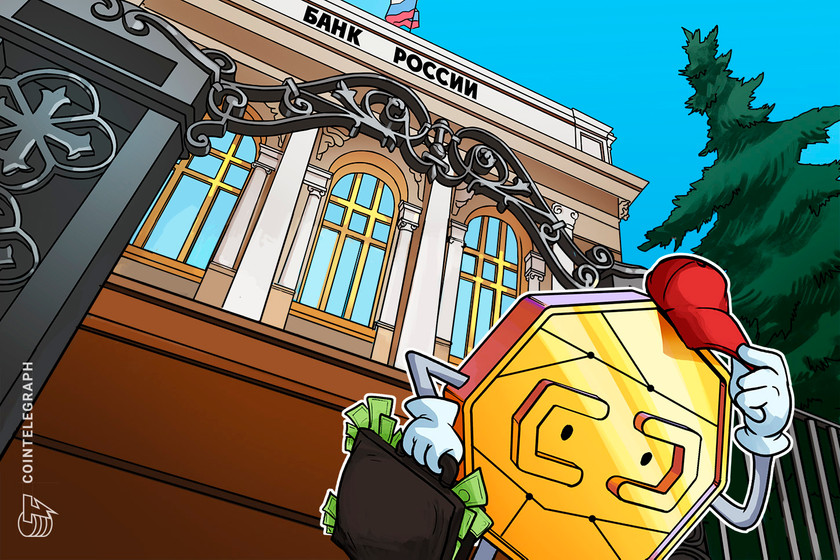Foreign trade and pensions: What’s next for Russia’s CBDC project?


The Russian digital ruble pilot launch was delayed until at least May, but the government still hopes to kick off the currency in 2024.
The pilot for Russia’s central bank digital currency (CBDC) pilot should have been launched on April 1, but it was delayed at practically the last moment due to the slow pace of the necessary associated legislation passing through parliament.
However, with the launch of the pilot still possible in May and the general roll-out of the digital ruble scheduled for 2024, the Russian project remains one of the most important CBDC developments to watch — especially given its possible role in cross-border payments between BRICS countries (Brazil, Russia, India, China and South Africa) and the intent to include it in the massive state-controlled pension system.
A brief timeline of Russia’s CBDC
The first time the Bank of Russia, the country’s central bank, announced its plans to explore the possibility of issuing a digital currency was in 2017. Back then, the bank’s first deputy governor, Olga Skorobogatova, said a CBDC would be a priority for the bank and that it would be looking into it in the near future.
However, at the time, Skorobogatova’s boss — Bank of Russia Governor Elvira Nabiullina — refused to acknowledge it as a “top priority,” instead calling it “a medium-term, or, perhaps, a long-term” prospect.
In 2022, the Bank of Russia revealed it planned to roll out the digital ruble across all banks in the country by 2024. The bank said the implementation would take place in stages and involve extensive testing and infrastructure development. It stated that the digital ruble would coexist with cash and non-cash payment systems, providing consumers more flexibility.
Perhaps the most significant factor in accelerating the CBDC’s development was the need for a reliable tool for foreign trade and settlement following Russia’s invasion of Ukraine and the subsequent sanctions implemented by several countries worldwide.
Magazine: Crypto regulation: Does SEC Chair Gary Gensler have the final say?
By early 2023, local media was reporting that the Bank Of Russia had begun studying two possible cross-border settlement models with the digital ruble.
In February 2023, Skorobogatova publicly announced that the first consumer pilot for the CBDC would take place on April 1, 2023. The experiment would involve 13 local banks and several merchants, as well as real consumers — though it would be limited to the employees of participating companies.
Russian state media subsequently reported that the pilot was delayed pending the passage of specific legislation by the State Duma, the lower chamber of the Russian parliament. The legislation will reportedly come into force no earlier than the beginning of May.
Elena Klyuchareva, senior associate at Russian law firm KKMP, told Cointelegraph that two laws would enable the digital ruble launch. The first is a bill on amendments to the Civil Code, which determines the legal nature of the digital ruble as “a form of non-cash money and contractual relations arising from the use of a digital account.”
The second is a bill on amendments to several laws, the main one being the “Law on National Payment System.” These amendments stipulate the basis for the functioning of the digital ruble platform and the responsibilities of its participants.
Both bills were adopted in the first reading by the State Duma on March 16, 2023. The term for commenting expired on April 14, 2023. “We may expect the continuation of its discussion soon, most likely in May,” Klyuchareva added.
Digitalization and retirees’ anxiety
Governor Nabiullina herself first suggested using the digital ruble in pension payments back in 2021, with few details regarding how it would work.
Discussions around the idea resurfaced at the end of March 2023 as the state-controlled Izvestia newspaper once again teased the CBDC pilot. Several weeks later, Nabiullina had to clarify that the digital ruble wouldn’t be the principal or even the common currency for pension payments but an additional option.


The pension system, for which the state is primarily responsible, is a traditionally sensitive area of politics and economics in Russia. With the elderly often being far from tech-savvy, the mention of something “digital” can provoke anxiety. However, Chris Emms, a former business developer at Bitcoin.com who now lives in Russia, said:
“The average Russian pensioner will still be able to spend their money in the exact same way and likely won’t even realize that their money is digital.”
Aleksandr Podobnykh, head of the Saint Petersburg branch of the Association of Chief Information Security Officers, also doesn’t see any potential tension.
He told Cointelegraph that while many citizens, including pensioners, will eventually interact with the digital ruble, the government will probably use some kind of incentivization policy to help people switch to the digital form of money. In fact, digitalization has been a priority for quite some time.
“Today, there are a huge number of initiatives and events aimed at improving the culture of citizens in the field of digital technologies and electronic services. Special attention is also paid to information on investment and security issues in this area,” Podobnykh said.
Will the digital ruble find adoption?
Will the digital ruble significantly affect the use of private cryptocurrencies in the country? All over the world, CBDCs are under development, and the crypto community at large perceives this as governments’ answer to the rise of digital money.
The Russian central bank has been highly hostile to any idea of legalizing crypto and even fought the Ministry of Finance on the matter. Podobnykh has no doubts about the bank’s plans regarding the new currency:
“Undoubtedly, with such an emphasis of the central bank on the monopoly use of the ruble, its position will remain strong. And don’t forget the plans to use it in calculations in the CSTO [Collective Security Treaty Organization] and BRICS countries.”
Emms sees the launch of the CBDC as a type of compromise between the anti-crypto central bank and the Russian politicians in the Duma who are “taking a positive stance over crypto regulation in general.” He believes the central bank hopes Russians will “choose to put their money into CBDC instead of buying high-risk altcoins.”
Recent: Connecting DeFi: How multichain token systems can improve liquidity
Klyuchareva said that the Bank of Russia expects the digital ruble to replace cryptocurrencies within Russia and be more popular as a safer instrument for settlements and investment. “Whether this expectation will come to life remains to be seen,” she concluded.
Speaking to the members of one of the parliamentary parties on April 17, Nabiullina didn’t refute the possibility of using cryptocurrency in foreign trade. Strangely enough, she didn’t specify whether this cryptocurrency would be private or issued by the central bank but mentioned the creation of “special entities responsible for mining.”
That makes the central bank’s stance on the digital ruble and private crypto less transparent — the “experimental” plan to mine some currency and the testing of a national CBDC for cross-border settlements seem to contradict each other. But one thing is certain, in Nabiullina’s words:
“Cryptocurrency shouldn’t be used inside the country.”



















